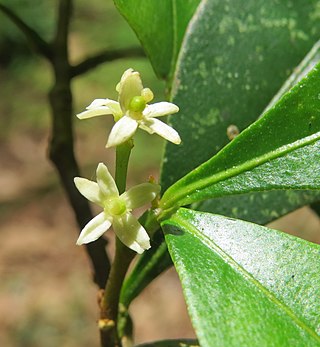
Acanthophoenix is a genus of flowering plants in the palm family from the Mascarene Islands in the Indian Ocean, where they are commonly called palmiste rouge. A genus long in flux, three species are currently recognized, though unsustainable levels of harvesting for their edible palm hearts have brought them all to near extinction in habitat. They are closely related to the Tectiphiala and Deckenia genera, differing in the shape of the staminate flower. The name combines the Greek words for "thorn" and "date palm".

Cyphophoenix alba is a species of palm in the family Arecaceae endemic to New Caledonia. It was previously placed in the genus Veillonia.

Zanthoxylum nitidum, commonly known as shiny-leaf prickly-ash, tez-mui or liang mian zhen, is a species of flowering plant in the family Rutaceae. It is a woody climber with prickles on the branchlets, thick, cone-shaped spines on the trunk and older branches, pinnate leaves with five to nine leaflets, and panicles or racemes of white to pale yellow, male or female flowers in leaf axils and on the ends of branchlets.

Zanthoxylum ovalifolium, commonly known as thorny yellowwood, oval-leaf yellow wood or little yellowwood, is a species of flowering plant in the family Rutaceae. It is a shrub or tree usually with trifoliate leaves, white, male and female flowers arranged in panicles in leaf axils or on the ends of branchlets and red, purple or brown follicles.
Zanthoxylum macranthum , is a species of woody plants in the family Rutaceae. It is native to the upland open forests and thickets in south-east Tibet and southern China, and has been found in Chongqing (Nanchuan), Guizhou, south-west Henan, western Hubei, Hunan, Sichuan, southern Yunnan (Xishuangbanna), and south-east Xizang.
Zanthoxylum austrosinense, or South Chinese Sichuan pepper, is a woody plant in the family Rutaceae and is native to southern China.

Zanthoxylum avicennae is a woody plant in the family Rutaceae.
Zanthoxylum calcicola is a woody plant in the Rutaceae family. It is native to Yunnan, Guizhou, and Guangxi in China.
Zanthoxylum echinocarpum is a woody plant in the family Rutaceae and is native to South-Central and Southeast China.
Zanthoxylum esquirolii is a woody plant in the family Rutaceae from Guizhou, Sichuan, and Yunnan China.
Zanthoxylum glomeratum is a woody plant in the Rutaceae family, it is native to Southeast and South-Central China.
Zanthoxylum khasianum is woody plant in the Rutaceae family native to Attam and South Central China.
Zanthoxylum laetum is a species of woody plant from the Rutaceae family.
Zanthoxylum leiboicum is a woody plant in the Rutaceae family and is native to Sichuan in China, and is known there as léi bō huā jiāo (雷波花椒).
Zanthoxylum liboense (Chinese: 荔波花椒 is a plant in the Rutaceae family.
Zanthoxylum micranthum is a woody plant in the family Rutaceae. It is native to Hubei, Hunan, Guizhou, Sichuan, and Yunnan provinces in China.
Zanthoxylum molle is a woody plant from the Rutaceae family.
Zanthoxylum motuoense is a woody plant from the Rutaceae family and is native to Medog, Tibet.
Zanthoxylum undulatifolium is a woody plant from the Rutaceae family. It is native to western Hubei, eastern Sichuan, Taibai Mountain in southern Shaanxi to the Three Gorges of the Yangtze River in China.
Zanthoxylum yuanjiangensis is a woody plant in the Rutaceae. It is native to Yuanjiang, Yunnan, China.




